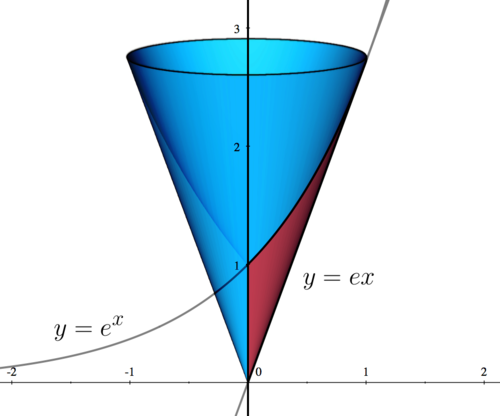Difference between revisions of "009B Sample Final 1, Problem 5"
Jump to navigation
Jump to search
| Line 110: | Line 110: | ||
!Final Answer: | !Final Answer: | ||
|- | |- | ||
| − | |'''(a)''' <math style="vertical-align: -5px">(1,e)</math> (See Step 1 for the graph) | + | | '''(a)''' <math style="vertical-align: -5px">(1,e)</math> (See Step 1 for the graph) |
|- | |- | ||
| − | |'''(b)''' <math style="vertical-align: -15px">\int_0^1 2\pi x(e^x-ex)~dx</math> | + | | '''(b)''' <math style="vertical-align: -15px">\int_0^1 2\pi x(e^x-ex)~dx</math> |
|- | |- | ||
| − | |'''(c)''' <math style="vertical-align: -14px">2\pi-\frac{2\pi e}{3}</math> | + | | '''(c)''' <math style="vertical-align: -14px">2\pi-\frac{2\pi e}{3}</math> |
|} | |} | ||
[[009B_Sample_Final_1|'''<u>Return to Sample Exam</u>''']] | [[009B_Sample_Final_1|'''<u>Return to Sample Exam</u>''']] | ||
Revision as of 14:11, 18 April 2016
Consider the solid obtained by rotating the area bounded by the following three functions about the -axis:
- , , and .
- a) Sketch the region bounded by the given three functions. Find the intersection point of the two functions:
- and . (There is only one.)
- b) Set up the integral for the volume of the solid.
- c) Find the volume of the solid by computing the integral.
| Foundations: |
|---|
| Recall: |
|
|
|
|
Solution:
(a)
| Step 1: |
|---|
| First, we sketch the region bounded by the three functions. The region is shown in red, while the revolved solid is shown in blue. |
| Step 2: |
|---|
| Setting the equations equal, we have |
| We get one intersection point, which is |
| This intersection point can be seen in the graph shown in Step 1. |
(b)
| Step 1: |
|---|
| We proceed using cylindrical shells. The radius of the shells is given by |
| The height of the shells is given by |
|
|
| Step 2: |
|---|
| So, the volume of the solid is |
|
|
(c)
| Step 1: |
|---|
| We need to integrate |
|
|
| Step 2: |
|---|
| For the first integral, we need to use integration by parts. |
| Let and Then, and |
| So, the integral becomes |
|
|
| Final Answer: |
|---|
| (a) (See Step 1 for the graph) |
| (b) |
| (c) |
























